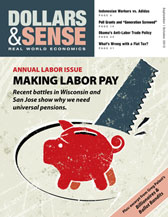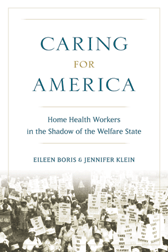This article is from Dollars & Sense: Real World Economics, available at http://www.dollarsandsense.org

This article is from the September/October 2012 issue of Dollars & Sense magazine.
Subscribe Now
at a 30% discount.

Care-Giving Controversies
A review of Caring for America: Home Health Workers in the Shadow of the Welfare State, By Eileen Boris and Jennifer Klein. New York: Oxford University Press, 2012.America‘s growing workforce of home-based care-givers has provided the labor movement with its main source of recent membership growth, during a period of overall union decline. Some of these gains were rolled back last year in states like Wisconsin, Ohio, and Michigan. There, Republican governors have undone the organizing deals—made by their Democratic predecessors with various unions—that created new bargaining units composed of state-funded home health aides and child-care providers. Tens of thousands of newly organized workers have, as a result, lost their precarious toehold on the bottom rung of public employment.
In other states, where funding has been reduced and direct-care jobs have been curtailed or eliminated, low-income Americans have suffered both as workers and clients. The predominantly female, largely non-white, and low-income labor force profiled in Caring for America continues to get organized where political conditions permit. In Connecticut, for example, 11,000 Medicaid-paid personal care attendants and state-funded daycare workers won union recognition earlier this year from labor-friendly legislators and new Democratic Governor Daniel Malloy.
However, as part of the nationwide conservative counter-attack against public sector unionism, multiple lawsuits were quickly filed to block this expansion of collective bargaining in New England. In 2008, the Service Employees International Union (SEIU) teamed up with the American Federation of State, County, and Municipal Employees (AFSCME) to win a statewide referendum authorizing homecare unionism in Missouri. Right-wing opponents there delayed first-contract bargaining until this spring, when the state Supreme Court finally upheld the results of a pro-union vote among 13,000 workers.
In California, meanwhile, Jerry Brown—like Connecticut‘s Malloy, a governor elected with strong labor support—vetoed a bill passed by his own Democrat-dominated legislature that would have allowed child care providers to unionize, more speedily, through a card-check process. Home health aides in the Golden State—who often care for someone in their own family—are already heavily unionized. But, citing fiscal constraints, Brown balked at extending bargaining rights to their counterparts in home-based child care.
History professors Eileen Boris and Jennifer Klein have written a timely and comprehensive guide to this new, contested terrain of home-based labor. Caring for America includes detailed case studies of successful home-care organizing (often aided by experienced ACORN organizers), while also providing valuable historical background on the emergence of this still largely invisible and undervalued workforce.
Prior to winning unions in close to twenty states, home health-care aides and child-care providers were classified as “independent contractors,” leaving them with little or no organizational voice in their “non-traditional” workplaces. Even with union representation, their jobs too often don‘t pay much and lack normal benefit coverage. Two-thirds of the 2.5 million workers who provide direct care in clients‘ homes are still awaiting action by the Obama administration to extend minimum wage and overtime law protections unfairly denied to them under the federal Fair Labor Standards Act.
As Boris and Klein document, the “deepest economic crisis since the Great Depression,” public-sector budget crises everywhere, and right-wing ascendancy in some state capitals, have exposed an “Achilles heel of the organizing model established by SEIU and copied by other unions.” As the authors note, top-down union victories are now vulnerable in a sector where the work was “already insecure and unstable, with constant turnover.” Home-based worker unionism will not survive, they suggest, unless “workers themselves have been able to build the union” through “member-to-member organizing,” rank-and-file leadership development, the creation of “social bonds,” and a continuing reliance on “mobilized political action”:
Unions must have social depth and a culture that enables them to live on when workers (or leaders or staff) move in and out and that sustain political activism at the state house where the budget and wages take shape. Those who do the work have to be at the table and part of the process. And when political deals fall through, there has to be power on the ground.
While they appreciate the economic gains made for home care workers in New York, California, and Illinois, the authors warn about the tendency toward a “bureaucratic unionism that reinforces the old racialized gender distinctions of care work and stymies the advancement of rank-and-file women.” Building real grassroots organization among home-based workers isolated from other union members and lacking traditional union structures (like a shop steward network) has never been easy. But, the authors argue, it is now more necessary than ever before in a “neoliberal age” of austerity and the dismantling of the welfare state.
The dramatic and unusual display of grassroots activism in Wisconsin last year has shown the potential for a different kind of public-sector unionism. During the winter of 2011, rank-and-filers in Madison broke with business as usual, by using direct action on the job in the form of teacher sick-outs and mass occupation of the state capitol to protest budget cuts and anti-union legislation.
For thousands of direct-care providers, the fight to defend recently acquired bargaining rights, modest first contact gains, or adequate program funding was an important, if little noticed, part of labor‘s larger struggle against Governor Scott Walker and his GOP clones elsewhere in the Midwest. Too often this campaign was couched, misleadingly, as a defense of “the middle class.” In reality, as Caring for America confirms, the working poor who care for other poor people—and many of us in other classes—haven‘t made it that far up the ladder yet. Their paltry pay, lack of benefits, and limited training and promotional opportunities all belie the importance of the work they do every day, in difficult, non-institutional settings. Organized labor would do well to put their continuing plight front and center because there are no union “fat cats” anywhere to be found in the fields of home care and child care in 21st century America.
Did you find this article useful? Please consider supporting our work by donating or subscribing.
